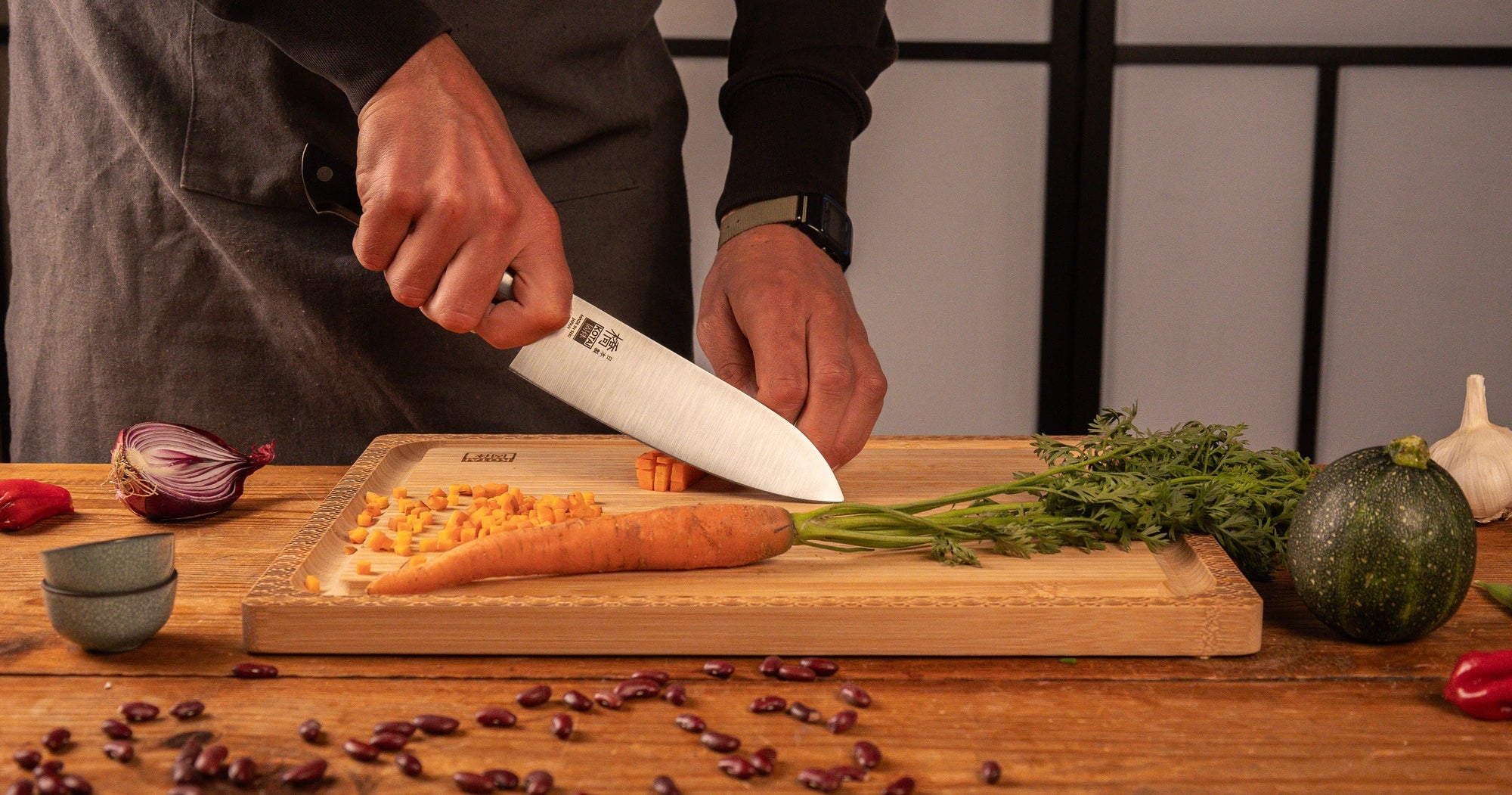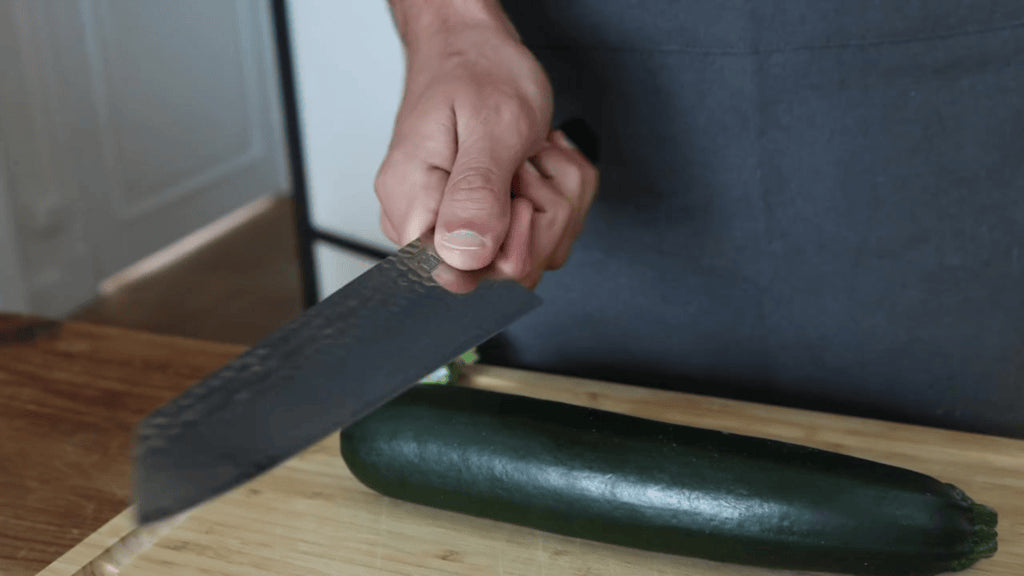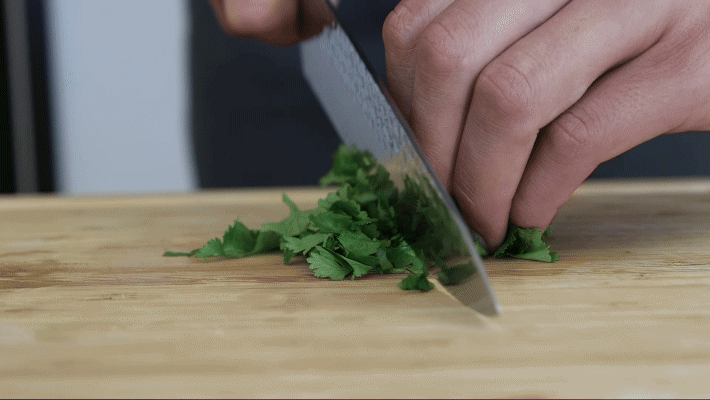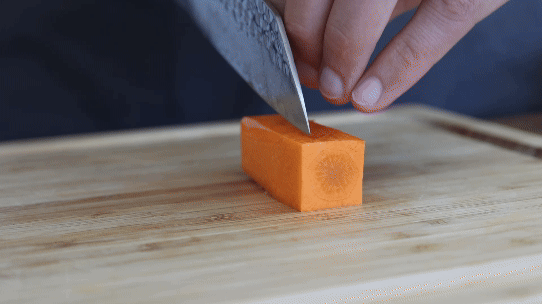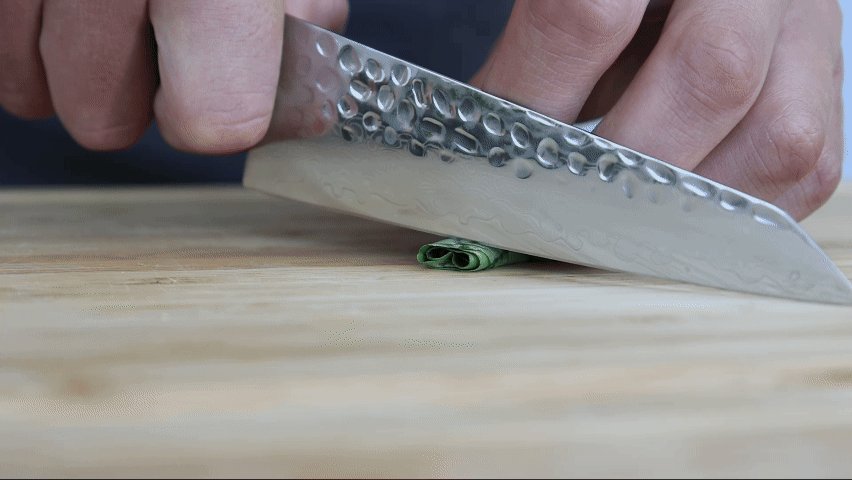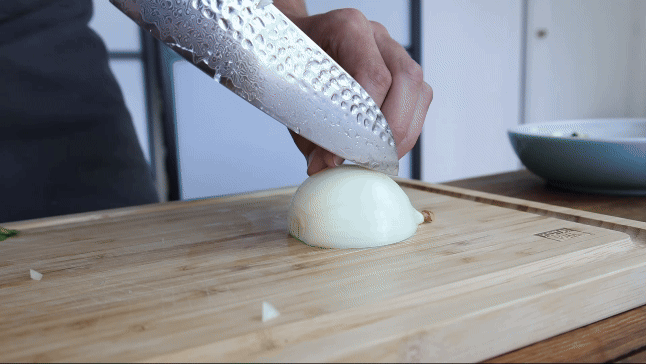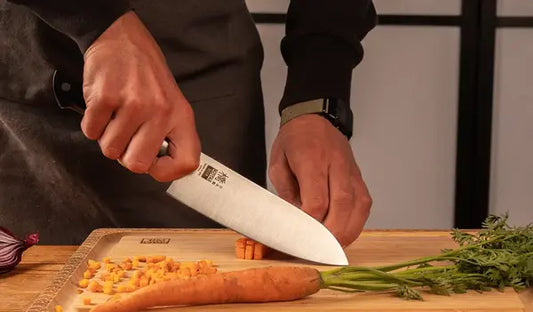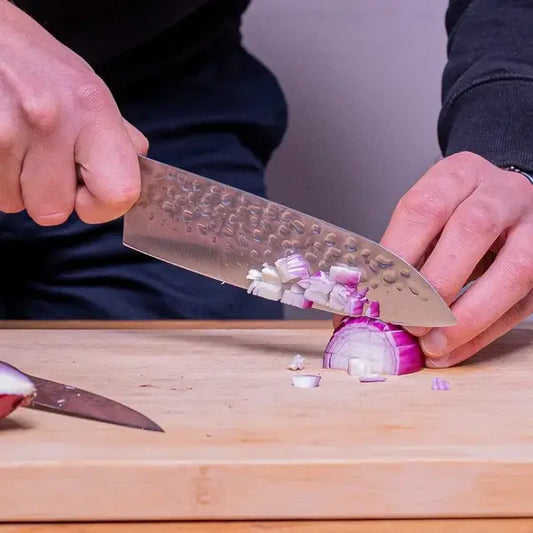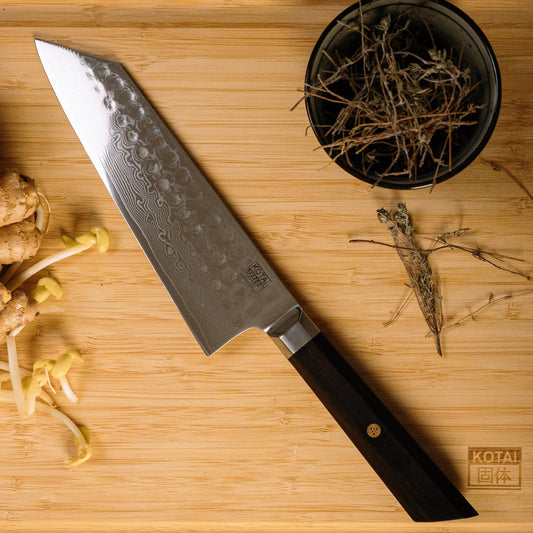Mastering your knife is the first step to cutting like a chef.
From cleaner slices to faster prep and fewer accidents, proper knife skills can elevate every meal you cook. It all starts with how you hold the blade and how you guide it, and just like professional chefs, you can learn the techniques that make every cut effortless and precise.
At KOTAI, we blend the sharp precision of Japanese craftsmanship with the strength and balance of Western design. Whether you’re dicing onions or julienning carrots, the right grip and the right knife make all the difference.
Let’s sharpen your skills.
A good grip for control and safety
The pinch grip: perfect control, just like a chef!
Still hesitant to handle large kitchen knives? This hesitation is common but disappears as soon as you learn how to hold a kitchen knife. The pinch grip, used by chefs around the world, offers total control over the knife.
By placing your thumb and index finger on either side of the blade’s base, the knife becomes an extension of your hand. It can be guided with incredible precision, without the risk of slipping or losing control.
🔎 Pro Tip: Pair this grip with a high-quality cutting board and a well-sharpened blade for impeccable results right from the start.
The hammer grip: for cuts that require power
Less popular than the pinch grip, the hammer grip is nonetheless a valuable technique. It involves wrapping all your fingers firmly around the handle of the kitchen knife, much like holding a hammer. This method is often instinctively adopted by beginners, and it proves useful for specific tasks.
The hammer grip is particularly effective for cutting hard foods, such as squash or thick carrots, where greater force is needed. It’s also ideal for handling heavy knives, such as butcher knives or cleavers like the one from our Pakka collection.
🔒 Safety Tip: To avoid any risk, use a non-slip cutting board and ensure your kitchen knife blade is well-sharpened. A sharp knife requires less pressure and greatly improves stability.
Finger Positioning: Ensuring Safe and Precise Cutting
Properly holding a kitchen knife also requires careful attention to finger positioning. Each hand has a key role in ensuring precision, fluidity, and safety during cutting.
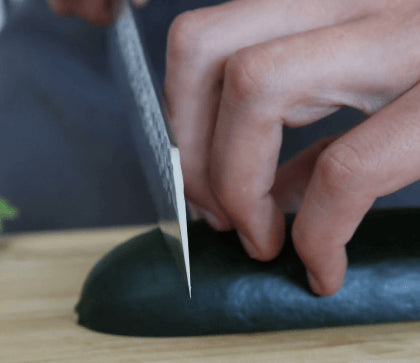
The dominant hand holds the knife with a firm yet relaxed grip, ensuring full control and minimizing the risk of slipping. The non-dominant hand plays an equally critical role. The fingers should curl slightly inward, mimicking the shape of a claw. The advanced knuckles protect the fingertips while acting as a guide for the blade.
🔎 Pro Tip: Practice this posture by starting with simple cuts on long vegetables, such as cucumbers or carrots.
Mastering Basic Cutting Techniques
Now that you know how to hold your knife like a chef, let’s explore the most useful cutting techniques you can apply right away in your kitchen. These movements help you cut faster, more precisely, and most importantly, more safely.
How to Rock Chop with a Chef’s Knife
The rock chop is a classic technique for mincing herbs and vegetables with smooth, controlled movements. To perform a rock chop, place the tip of your knife firmly on the cutting board and keep it there. Then, lift and lower the handle in a rocking motion while your non-dominant hand gently pushes the ingredient forward. Your fingers should be curled into a claw shape, with your knuckles guiding the side of the blade to keep your fingertips out of harm’s way.
This method is especially effective for finely chopping parsley, garlic, or onions while maintaining a steady rhythm. It’s the kind of motion our Gyuto knives are built for. Their curved blade profile makes rocking cuts effortless.
→ Try the Hashi Tsuchime 200 mm Gyuto knife
How to Cross Chop for Speed and Precision
Cross chopping is ideal when you want to cut small ingredients quickly, like herbs or soft vegetables. Similar to the rock chop, keep the tip of the knife anchored to the cutting board while lifting and lowering the handle. Your non-dominant hand rests gently on the spine of the blade to guide and control the motion. The curved belly of the knife makes this rhythmic chopping smooth and fluid.
For cross chopping, our Gyuto knives excel with its balanced curve that allows fast, precise cuts without strain.
→ Check out the Pakka 200 mm Gyuto knife
How to Chop Vegetables Cleanly and Safely
The basic chop is a straightforward up-and-down cutting motion, perfect for slicing firm vegetables like carrots, celery, and squash. Begin by creating a flat surface on the ingredient to keep it stable. Hold the food with your non-dominant hand in the claw position, curling your fingers inward for protection. With your knife blade resting gently against your knuckles, lift the entire knife and press down in a clean, even motion.
This technique works best with a knife designed for vertical chopping. The Nakiri knife, with its tall, straight blade, provides maximum control and clean, uniform cuts when chopping vegetables.
→ Explore the Hashi Classic 165 mm Nakiri knife
How to Slice with a Pull Cut
The pull cut, or slicing technique, is perfect for delicate ingredients that bruise easily, such as fresh herbs, fish, or soft-skinned vegetables. Begin by layering or rolling the ingredient, like a bundle of basil leaves. Place the tip of the knife on the cutting board with the blade resting lightly against your knuckles. Hold the knife at a slight angle, then pull it back toward you in a smooth motion until the blade slices completely through.
For this precise slicing, a Petty or Santoku knife is ideal. Their thin, sharp blades glide effortlessly through delicate foods.
→ Discover the Bunka 170 mm Santoku knife and the Bunka 135 mm Petty knife
Types of Cuts Every Home Chef Should Master
How to Julienne Vegetables
The julienne cut transforms vegetables into thin, uniform matchsticks. Each piece should be about 8 cm long and 3 mm thick. This cut is perfect for salads, stir-fries, or elegant garnishes. Start by trimming the ends and squaring off your vegetable, then slice it into thin slabs, stack them, and cut into strips.
For clean, controlled slicing, use a Santoku knife. Its blade is more compact than a traditional chef’s knife, making it ideal for precision cuts like julienne.
→ Discover the Pakka 180 mm Santoku knife
How to Cut in Batonnet or Baton Style
The batonnet cut is similar to julienne but thicker. It’s typically used for cutting vegetables into fry-sized sticks. A batonnet measures around 6 cm long and 6 mm thick, while a larger baton is closer to 2 cm by 7 cm and often used for classic French fries.
Use a Gyuto knife for its long, balanced blade, which helps maintain clean, straight cuts through firm vegetables.
→ Explore the Hashi Classic 180 mm Gyuto knife
How to Cut in Brunoise
Brunoise is a fine dice, often used in sauces, soups, and garnishes. To create a brunoise, start by julienning your vegetable, then turn the strips and dice them into tiny 3 mm cubes. Carrots, leeks, and celery are commonly cut this way.
You can use a Nakiri knife for its straight edge and high blade, which help keep your cuts uniform and safe.
→ Check out the Hashi Tsuchime 165 mm Nakiri knife and the Pakka Damascus 200 mm Gyuto knife
How to Make a Paysanne Cut
Paysanne cuts are thin, rustic slices made after cutting food into larger batonnet-style pieces. These slices often follow the natural shape of the vegetable and work well in soups like minestrone or stews.
For a comfortable and steady hand, a Santoku knife is a great match thanks to its broad blade and lightweight feel.
→ View the Hashi Tsuchime 170 mm Santoku knife
How to Chiffonade Herbs
The chiffonade technique is used for leafy greens and herbs like basil. Stack the leaves, roll them tightly, and slice across the roll to create fine ribbons. These delicate strips are often used as garnishes or added at the end of cooking for flavor.
The Petty knife is ideal here. Its small, nimble blade gives you full control for precision slicing.
→ Try the Hashi Tsuchime Petty knife
How to Dice Vegetables
Dicing creates small cubes of varying sizes, depending on your recipe. It’s similar to brunoise, but usually larger. First, julienne your ingredient, then cut crosswise into cubes. Dicing is perfect for stir-fries, salsas, or roasted vegetables.
The Nakiri knife and the Gyuto knife work well for even cubes, especially on firmer vegetables like carrots or potatoes.
→ Use the Hashi Classic 165 mm Nakiri knife or the Hashi Damascus 200 mm Gyuto knife for clean dicing
How to Cut Potatoes in Pont-Neuf Style
The Pont-Neuf cut is a traditional French method for thick potato sticks. Cut your peeled potatoes into rectangular slabs about 2 cm by 7 cm. This technique is ideal for oven fries or chunky fried potatoes.
For straight, sturdy cuts, go with a Gyuto knife or a Kiritsuke knife, both of which offer strength and balance.
→ See the Pakka 200 mm Gyuto knife or a Bunka 210 mm Kiritsuke knife
Tips for Using Your Knives Effectively
Japanese and Western knives don’t have exactly the same characteristics. Knowing how to use them properly will allow you to cut like a chef while preserving the quality of your blades.
Some knives have a cutting angle of 20° to 25°. In contrast, our knives, designed with a cutting angle of 15°, feature thinner blades that are perfect for precise cuts. They support straight or pull movements, making them ideal for finely slicing vegetables, fish, or other delicate foods. The Gyuto, with its slightly curved blade, also excels in rocking motions, suitable for meat, herbs, and fish.
🔒 Practical Tip: To ensure precise and long-lasting cuts, a 15° angle guide is included in our 180/800 and 2000/6000 sharpening stone sets.
To sum up…
Handling a kitchen knife is more than just a skill. It’s an art.
With the right grip, safe finger positioning, sharp tools, and proper technique, every cut becomes cleaner, faster, and more precise. It's not just about following steps, but about building confidence and rhythm in the kitchen.
With regular practice, using your knife becomes second nature. You'll move more efficiently, enjoy cooking more, and approach each ingredient with purpose. Most importantly, cutting like a pro means staying adaptable, caring for your tools, and trusting your hands.
→ Check out our Tips for Knife Maintenance

